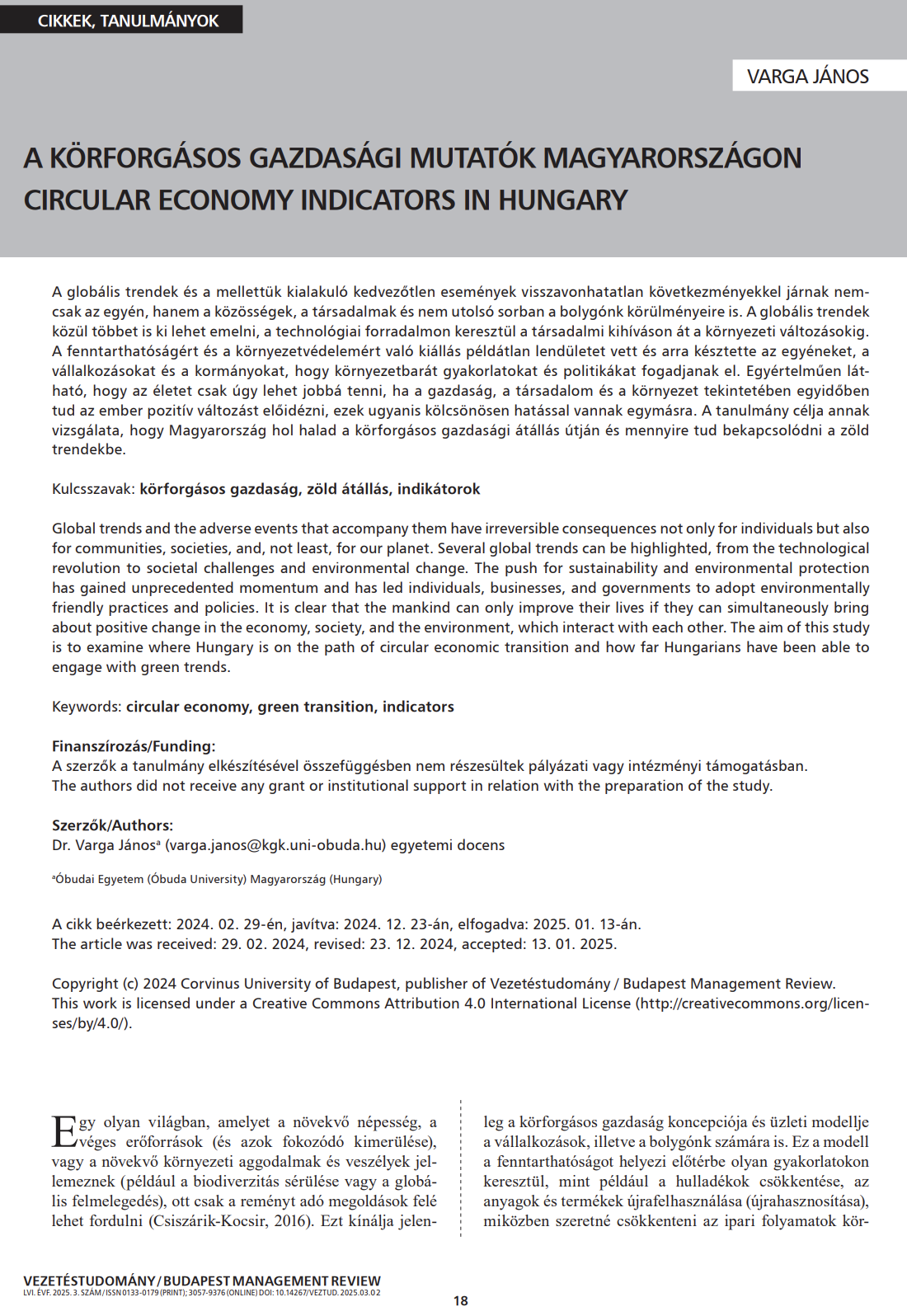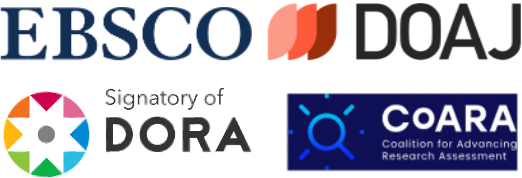Circular economy indicators in Hungary
DOI:
https://doi.org/10.14267/VEZTUD.2025.03.02Keywords:
circular economy, green transition, indicatorsAbstract
Global trends and the adverse events that accompany them have irreversible consequences not only for individuals but also for communities, societies, and, not least, for our planet. Several global trends can be highlighted, from the technological revolution to societal challenges and environmental change. The push for sustainability and environmental protection has gained unprecedented momentum and has led individuals, businesses, and governments to adopt environmentally friendly practices and policies. It is clear that the mankind can only improve their lives if they can simultaneously bring about positive change in the economy, society, and the environment, which interact with each other. The aim of this study is to examine where Hungary is on the path of circular economic transition and how far Hungarians have been able to engage with green trends.
Downloads
References
Arruda, E.H., Melatto, R.A.P.B., Levy, W., & de Melo Conti, D. (2021). Circular economy: A brief literature review (2015-2020). Sustainable Operations and Computers, 2, 79-86. https://doi.org/10.1016/j.susoc.2021.05.001.
Csiszárik-Kocsir, Á. (2016). A megújuló energiaforrások projektfinanszírozása a 2005 és 2015 között végrehajtott tranzakciók alapján. Journal of Central European Green Innovation, 4(3), 127-141. https://ageconsearch.umn.edu/record/253391/?v=pdf
Csiszárik-Kocsir, Á., & Lentner, Cs. (2023). Financial exclusion from the perspective of financial literacy in the digital world of the 21st century through the example of Hungary. Transformations in Business and Economics, 22(3), 266-280. https://tudasportal.uni-nke.hu/xmlui/handle/20.500.12944/21357
Ekins, P., Domenech, T., Drummond, P., Bleischwitz, R., Hughes, N. & Lotti, L. (2019). The Circular Economy: What, Why, How and Where. Studocu. https://www.studocu.vn/vn/document/truong-dai-hoc-ngoaithuong/business-economics/ekins-2019-circular-economy-what-why-how-where/67699481
European Environment Agency. (2021). Ecological footprint of European countries. www.eea.europa.eu/en/ analysis/indicators/ecological-footprint-of-european-countries
European Parliament. (2018). Hulladékkezelés az EU-ban. Trendek és statisztikák. https://www.europarl.europa.eu/news/hu/headlines/society/20180328STO00751/hulladekkezeles-az-eu-ban-trendek-es-statisztikak-infografika
European Parliament. (2023). Az üvegházhatású gázok kibocsátása az EU-ban. https://www.europarl.europa.eu/news/hu/headlines/society/20180301STO98928/uveghazhatasu-gazok-kibocsatasa-az-eu-ban-infografika
Garai-Fodor, M. (2023). Digitalisation trends based on consumer research. In Szakál, A. (Eds.), IEEE 17th International Symposium on Applied Computational Intelligence and Informatics SACI (pp. 349-352). IEEE Hungary Section. https://doi.org/10.1109/SACI58269.2023.10158614
Garai-Fodor, M., Vasa, L., & Jäckel, K. (2023). Characteristics of consumer segments based on perceptions of the impact of digitalisation. Decision Making: Applications in Management and Engineering, 6(2), 975- 993. https://doi.org/10.31181/dmame622023940
Geissdoerfer, M., Savaget, P., Bocken, N.M., & Hultink, E.J. (2017). The circular economy – a new sustainability paradigm? Journal of Cleaner Production, 143, 757-768. https://doi.org/10.1016/j.clepro.2016.12.048.
Horváth, A. (2019). Körforgásos gazdálkodás eszméi, a körkörös ellátási lánc menedzsment. Logisztikai Trendek és Legjobb Gyakorlatok, 5(2), 47-52. https://doi.org/10.21405/logtrend.2019.5.2.47
Kirchherr, J., Nadja Yang, N.H., Schulze-Spüntrup, F., Heerink, M.J., & Hartley, K. (2023). Conceptualizing the Circular Economy: An Analysis of 221 Definitions. Resources, Conservation and Recycling, 194, 107001. https://doi.org/10.1016/j.resconrec.2023.107001.
Korhonen, J., Honkasalo, A., & Seppälä, J. (2018). Circular economy: the concept and its limitations. Ecological Economics, 143(1), 37-46. https://doi.org/10.1016/j.ecolecon.2017.06.041
Kozma, D.E, Molnárné, B.K., & Molnár, T. (2021). Rangsoroljunk vagy nem? – A körforgásos gazdaság mérési lehetőségei és azok összehasonlítása az EU-tagországokban. Vezetéstudomány, 51(8-9), 63-77. https://doi.org/10.14267/VEZTUD.2021.09.05
Lamba, H.K., Kumar, N.S., & Dhir, S. (2024). Circular economy and sustainable development: a review and research agenda. International Journal of Productivity and Performance Management, 73(2), 497-522. https://doi.org/10.1108/IJPPM-06-2022-0314
Moraga, G., Huysveld, S., Mathieux, F., Blengini, G.A., Alaerts, L., Van Acker, K., & Dewulf, J. (2019). Circular economy indicators: what do they measure? Resources Conservation Recycling, 146, 452-461. https://doi.org/10.1016/j.resconrec.2019.03.045
Németh, K. (2021). A körforgásos gazdaság alapjai. Pannon Egyetemi Kiadó.
OECD. (2018). Global Material Resources Outlook to 2060. https://www.oecd.org/en/publications/global-material-resources-outlook-to-2060_9789264307452-en.html
Shooshtarian, S., Maqsood, T., Caldera, S., & Ryley, T. (2022). Transformation towards a circular economy in the Australian construction and demolition waste management system. Sustainable Production and Consumption, 30, 89-106. https://doi.org/10.1016/j.spc.2021.11.032
Silva, F.C., Shibao, F.Y., Kruglianskas, I., Barbieri, J.C., & Sinisgalli, P.A.A. (2019). Circular economy: analysis of the implementation of practices in the Brazilian network. Revista de Gestão, 26(1), 39-60. https://doi.org/10.1108/REGE-03-2018-0044
Stahel, W. (2016). The circular economy. Nature, 531, 435- 438. https://doi.org/10.1038/531435a
Szigeti, C., Remsei, S., & Bándy, K. (2023a). What are the Young People’s Perceptions of the Circular Economy? In Nedelko, Z., & Korez Vide, R. (Eds.), Conference Proceedings of the 7th FEB International Scientific Conference: Strengthening Resilience by Sustainable Economy and Business – Towards theSDGs (pp. 455- 462). University of Maribor Faculty of Economics and Business.
Szigeti, C., Remsei, S., & Bándy, K. (2023b). Körforgásos fogalmak és értékek: divat lesz-e az újrahasználat? In Vágány, J., & Fenyvesi, É. (Eds.), Multidiszciplináris kihívások, sokszínű válaszok: 11. Tudományos Szimpózium: absztraktfüzet (p. 65). Budapesti Gazdasági Egyetem. http://real.mtak.hu/id/eprint/165388
Tóth, T.G. (2023). A jövő körforgásos és platform gazdasága. Tallózó, 2(1), 109-112. https://doi.org/10.14267/VILPOL2023.01.14
Yale University. (2022). Environmental Performance Index. https://epi.yale.edu/epi-results/2022/component/epi

Downloads
Published
How to Cite
Issue
Section
License
Copyright (c) 2025 Corvinus University of Budapest, publisher of Vezetéstudomány / Budapest Management Review

This work is licensed under a Creative Commons Attribution 4.0 International License.
Authors assign copyright to Vezetéstudomány / Budapest Management Review. Authors are responsible for permission to reproduce copyright material from other sources.

